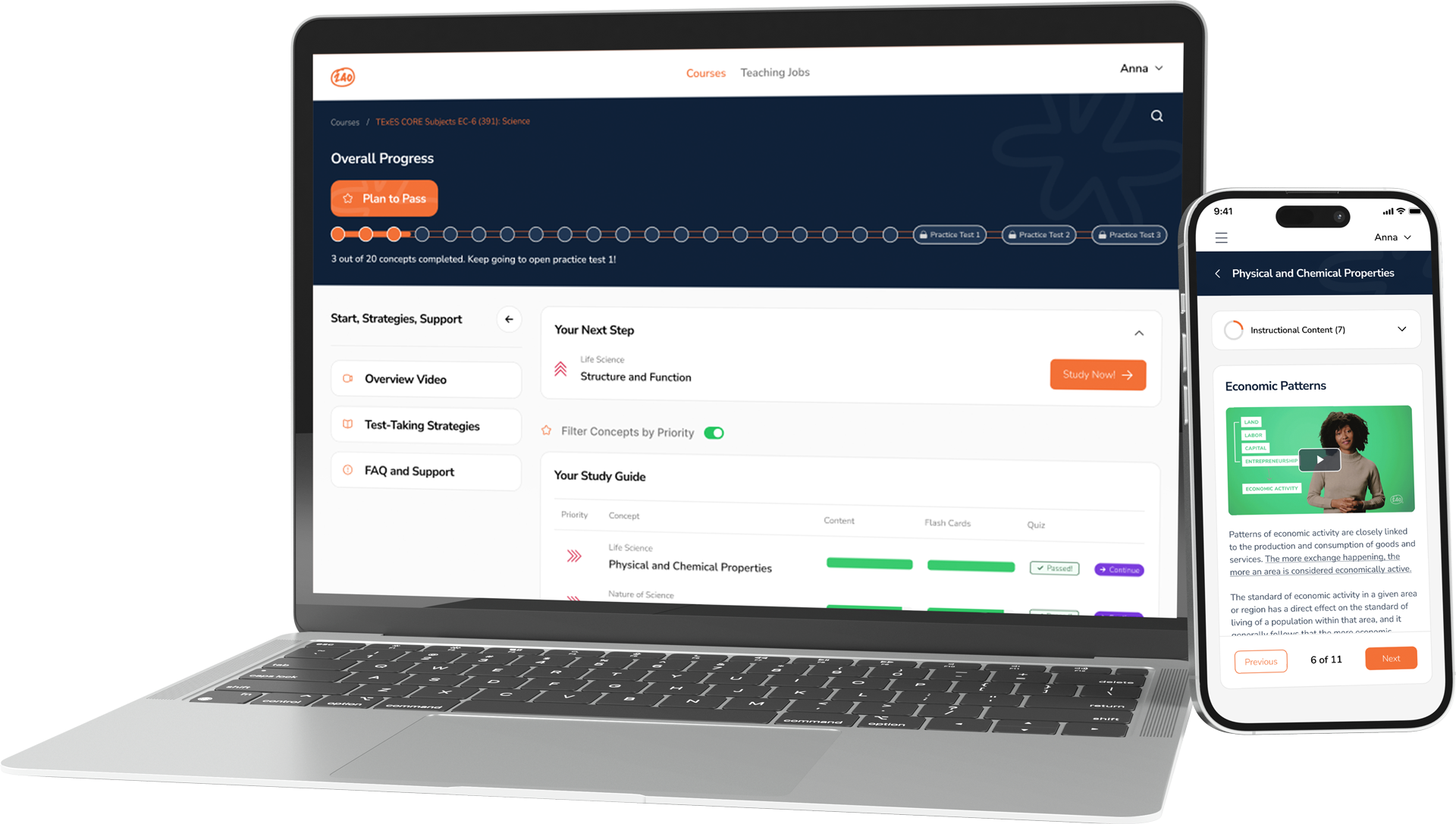Not sure where to start? Let us help! 💪
I'm a teacher candidate at a university/college I'd like to transition to teaching I'm a current / former teacher I'm in leadership for K-12 or Higher Ed (EPP)Reading for Virginia Educators: Elementary and Special Education Study Guide and Practice Questions

Welcome to the RVE Elementary and Special Education test study guide prep, which includes practice questions. We’ll be introducing you to the content categories you need to know to pass this exam. This is one of the free resources we provide so you can see the high-level concepts you will find on the Reading for Virginia Educators test to gauge how much you know.
Quick Links to Help You Navigate This Page
RVE Test Information
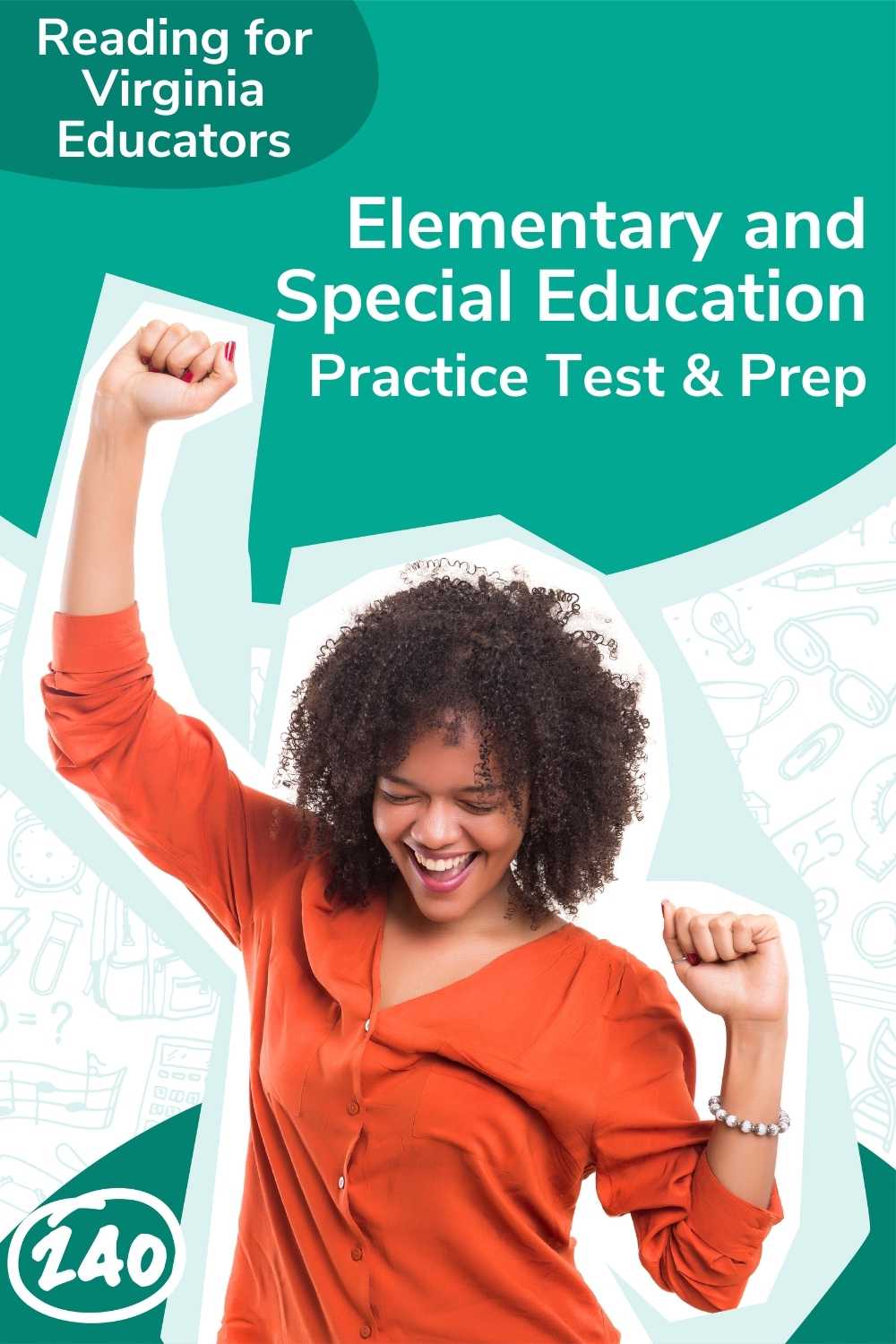 This test will assess your knowledge of elementary reading and writing skills and reading development. It is designed for entry-level teachers who have completed a necessary training program to teach elementary reading. Its purpose is to ensure that you have the necessary knowledge and skills to teach elementary-level reading.
This test will assess your knowledge of elementary reading and writing skills and reading development. It is designed for entry-level teachers who have completed a necessary training program to teach elementary reading. Its purpose is to ensure that you have the necessary knowledge and skills to teach elementary-level reading.
Format:
The test includes 100 selected-response questions and 3 constructed-response questions (short answer or essay). You will have 2.5 hours to complete the test, but the entire testing process will take about 3 hours to allow for test instructions and tutorials.
Within the 100 selected-response questions, there are four categories of questions. Each category is listed below, along with the approximate number of questions for that category:
- Assessment and Diagnostic Teaching: 19 questions
- Oral Language and Oral Communication: 19 questions
- Reading Development: 43 questions
- Writing and Research: 19 questions
The three constructed-response questions include one question for each of the following topics:
- Analysis of assessment and diagnostic teaching
- Application of reading development knowledge
- Analysis and application of writing and research
Each constructed-response question contributes equally to your overall score.
While the test sections are not individually timed, you should plan to spend about 1 hour and 45 minutes on the selected-response questions and 15 minutes on each constructed-response question.
Cost:
$130
Scoring:
This test has a scoring range of 100 – 200 and a minimum passing score of 157.
Study time:
Study time will vary from person to person, but you should plan on allowing yourself several weeks to prepare. Plan to study until you feel comfortable answering all practice questions. It may be helpful to create a study schedule to ensure you will have time to study each section of the test.
What test takers wish they would’ve known:
- Pay close attention to questions that include the words “not” or “except,” indicating that you need to choose the answer choice that does not fit the question.
- Do not overthink the questions – there are no “trick questions” on the test.
- There is no penalty for incorrect answers, so it is better to guess if you do not know an answer.
- While most questions will involve selecting one option from a list of answer choices, some questions may ask you to select answers from a drop-down menu, drag answer choices to the correct place, or click on multiple answer choices from a list. There will always be clear instructions for how you should respond to questions such as these.
- Pay attention to the time. In general, you should plan to spend about 1 hour and 45 minutes on the multiple-choice questions and 15 minutes on each constructed-response question.
Information and screenshots obtained from the ETS PRAXIS website:
RVE Part A: Selected-Response Questions
Part A of the Reading for Virginia Educators exam has about 100 multiple-choice questions.
This part has four sections:
- Assessment and Diagnostic Teaching
- Oral Language and Oral Communication
- Reading Development
- Writing and Research
So, let’s start with Assessment and Diagnostic Teaching.
Assessment and Diagnostic Teaching
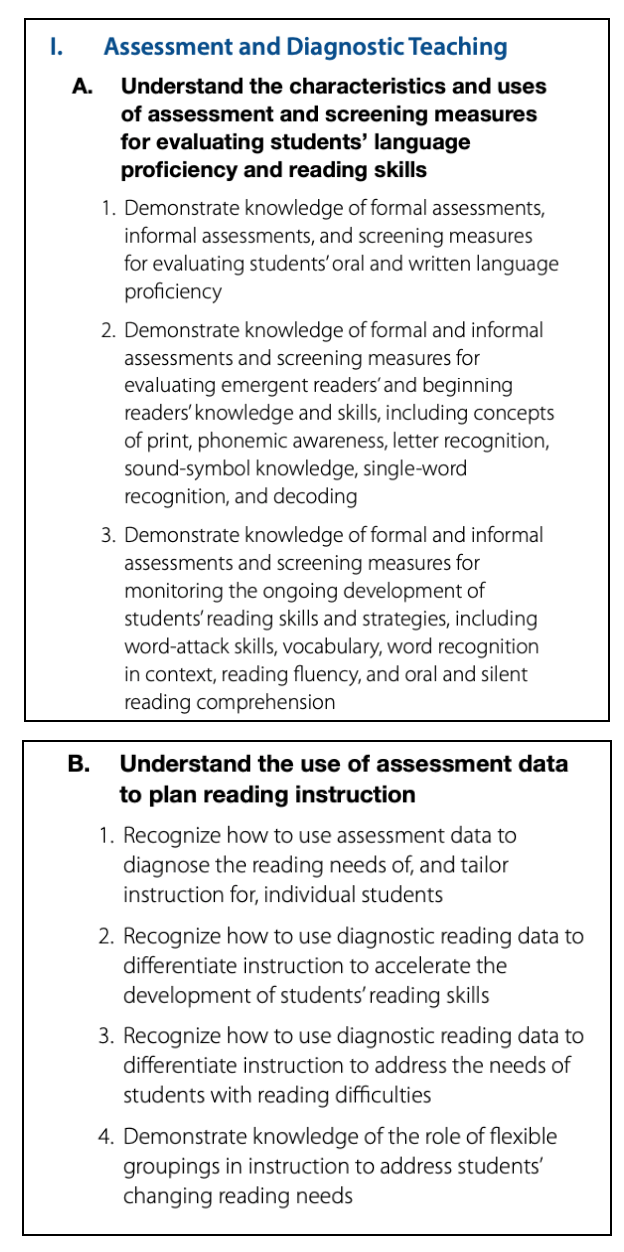
There are about 19 Assessment and Diagnostic Teaching questions.
This section tests your knowledge on various assessments and screening measures, as well as how to use the results from these assessments to help plan and guide instruction.
Let’s discuss some concepts that will more than likely appear on the test.
Running Records
Running records are used to assess a student’s reading level and to help plan individualized instruction for that student. A running record tells you the student’s accuracy percentage for a reading passage, shows specific areas of instruction to focus on for that student, and gives insight into their thinking process while they are reading. They can be used to plan instruction, track student progress, and place students into appropriate guided reading groups in class.
To take a running record, use a pre-selected reading passage from a book. While the student is reading aloud, you will mark errors and certain reading strategies using the marking system shown below. After the child is finished reading, you will calculate their accuracy percentage in the following manner:
- Total Words – Total Errors = Score
- ScoreTotal Words
100 = Accuracy Percentage
- Accuracy of less than 90% means the text is too hard for the student, and they should be moved to a lower reading level.
- Accuracy of 90% – 92% means the text is a challenging instructional text, and the student will need direct support to read and comprehend the book. The child should likely be moved to a lower reading level.
- Accuracy of 93% – 95% means the text is an appropriate instructional text. This is a good reading level for the student to read both independently and in groups.
- Accuracy of 96% – 100% means the text is too easy, and the student should be moved to a higher reading level so they can continue to make progress.
For an example of a running record, as well as how to score a running record, check out this resource: https://www.readinga-z.com/helpful-tools/about-running-records/marking-a-running-record/
Process Interview
A process interview is an informal assessment used by teachers to gain information about a student’s thought process while they are reading or writing. It helps the teacher understand what a student is thinking about while they are working. Questions that a teacher might ask a student during a process interview include:
- Can you tell me why you chose this book?
- What do you think this book will be about?
- What are you thinking about while you read?
- What was this page of the book about?
- What do you do when you get to a word you don’t know?
- What does this story remind you of?
- Can you tell me more about what you are writing?
- How did you decide how to spell this word?
The teacher will then use the student’s responses to help guide instruction by focusing on areas that the student may have struggled with, such as comprehension or text connections.
Norm-Referenced versus Criterion-Referenced Assessments
Norm-referenced and criterion-referenced tests are both ways to assess students, but the difference lies in the scores and how these scores are interpreted.
In a norm-referenced assessment, a student’s score is compared with the scores of their peers, or the “norm group.” The norm group is usually students of the same age or grade level. Scores from norm-referenced tests are usually reported as a percentile. For example, if a student’s score is shown as the 25th percentile, this means they performed higher than 25% of students in their peer group. Scores may also be reported as “well below average, below average, average, above average, or well above average.”
In a criterion-referenced assessment, a student’s score is compared with a predetermined standard or performance level. The scores and cut-off values for each performance level do not change based on how other students do on the assessment. A student’s score on a criterion-referenced assessment will show you how they performed in relation to the test standards, but not how they performed when compared with peers.
The main difference between criterion-referenced tests and norm-referenced tests is that norm-referenced tests compare students’ scores to their peers. A student may score in the 90th percentile at the beginning of the year on a norm-referenced test but score in the 30th percentile at the end of the year if they did not make as much progress throughout the year as other students.
Flexible Grouping
Flexible grouping is a way to group students to help differentiate instruction. For example, students can be put into small groups for guided reading, partners for buddy reading, or groups for a variety of other lessons and station activities. Assessment data (both formal and informal) and teacher observations are used to create student groups.
The way in which students are grouped depends on the goal of the lesson. For example, students with similar abilities or a similar reading level may be grouped together for a guided reading lesson with the teacher, while students of varied abilities may be grouped together for a group project so that students can help each other.
Using flexible grouping can be a very effective way to teach because it allows the teacher to meet the needs of all students and reach them at their current level. It also encourages student collaboration and helps students learn from their peers.
Oral Language and Oral Communication
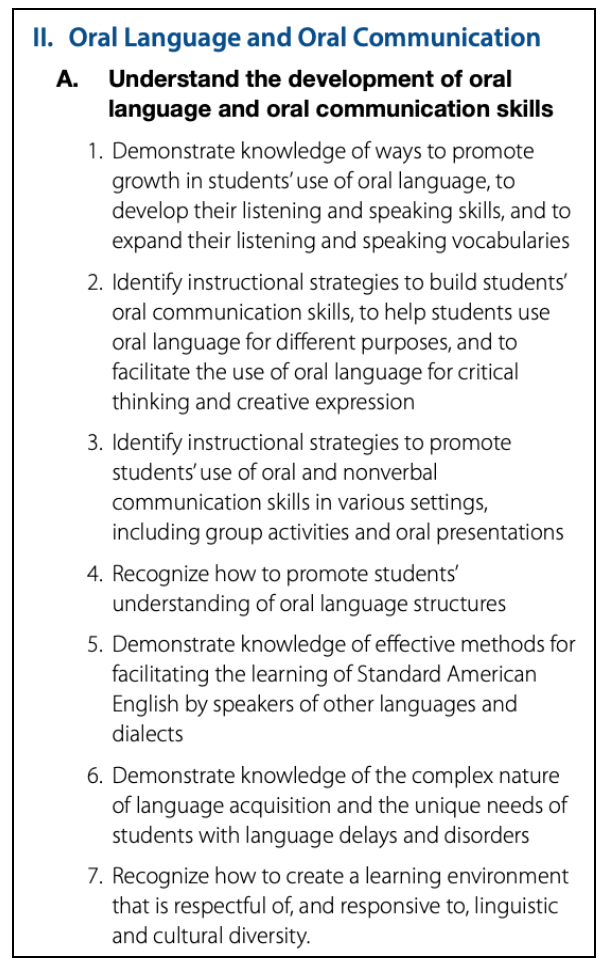

There are about 19 Oral Language and Oral Communication questions.
This section tests your knowledge on the development of oral language, including specific strategies used to teach phonological awareness and phonemic awareness.
Here are some concepts that you may see on the test.
Phonological Awareness
Phonological awareness includes identifying and working with units of sound in words, such as syllables, onsets and rimes, and phonemes. Phonological awareness is a crucial component of teaching children to read and spell. Children who do not have a solid foundation in phonological awareness will often struggle with reading skills later on. Phonological awareness should be taught directly and explicitly for approximately 10 – 15 minutes each day, as part of the overall reading time.
Phonemic Awareness
Phonemic awareness is one aspect of phonological awareness. Phonemic awareness is the ability to hear, identify, and manipulate phonemes in a word. A phoneme is the smallest individual unit of sound in a word. For example, the word “dog” has three phonemes (/d/-/o/-/g/). The word “grab” has four phonemes (/g/-/r/-/a/-/b/). The amount of phonemes does not always correspond to the number of letters. For example, the word “chat” has four letters, but only three phonemes (/ch/-/a/-/t/).
Phonemic awareness is important in the foundation of early reading development and is one of the first steps in teaching phonics to children.
A typical sequence for teaching phonemic awareness is as follows:
- Rhyming: Students first identify words that do and do not rhyme, followed by generating rhyming words.
- Segmenting and blending onsets and rimes: An onset is the initial sound of a word or syllable, and the rime is the remaining sounds. At this stage, students would be able to hear something such as, “/c/ – /at/” and blend it to say “cat.”
- Segmenting and blending phonemes: At this stage, students would be able to segment a word into its different phonemes. For example, if they heard the word “back,” they would be able to say, “/b/-/a/-/ck/.” They should also be able to blend a word together after hearing the individual phonemes. For example, the teacher would say, “/b/-/a/-/ck/” and the student would say, “back.”
- Deleting and manipulating phonemes: This involves changing a word by removing or changing one or more phonemes. For example, a teacher might ask, “What is farm without the /f/?” and the student would say, “arm.”
English Language Learners
English Language Learners are students who are in the process of learning English. They typically come from homes or families where the main language that is spoken is something other than English. They may struggle with communicating in English or with learning effectively when English is the language they are being taught in. English Language Learners can range from students who cannot speak or understand any English to students who can communicate almost fluently in English but still struggle with some English academic language.
Students who are English Language Learners often need information presented in a variety of different ways, including visual representations. Effective strategies for helping English Language Learners include using visual aids and graphic organizers, providing necessary background knowledge before a lesson, assigning the student a peer to help them, providing sentence starters (such as, “I think ____ because _____”), and allowing for extended wait time while they process new information.
Reading Development
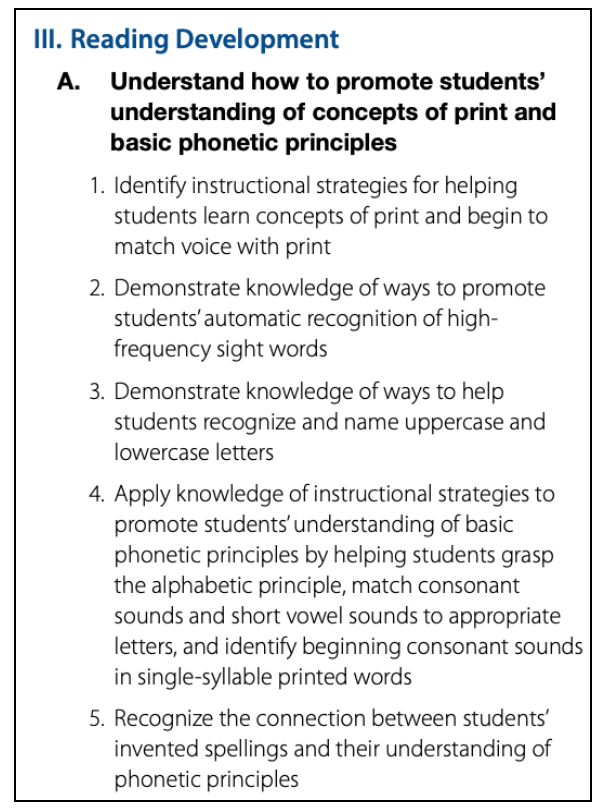

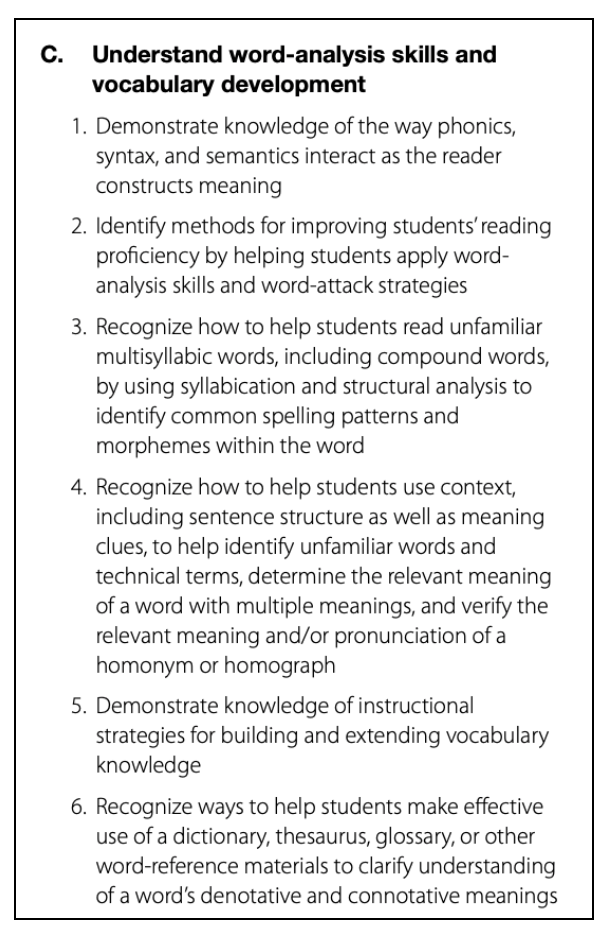
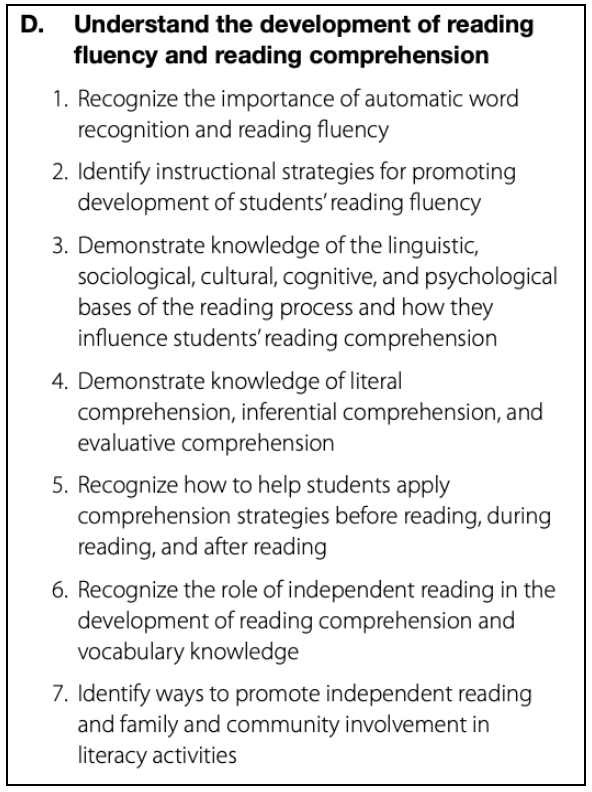
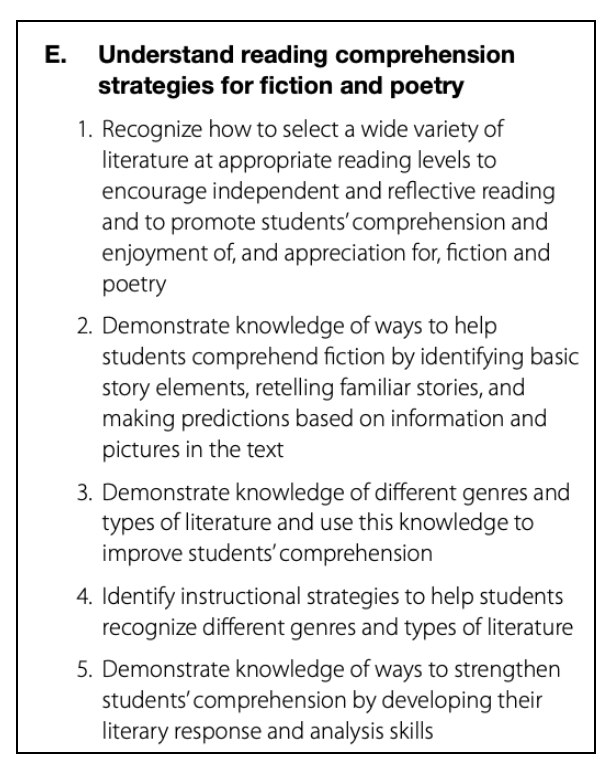

There are about 43 Reading Development questions.
This section tests your knowledge on specific skills and instructional strategies related to reading and comprehension, including phonics, stages of reading development, and comprehension strategies.
Let’s look at some concepts that are guaranteed to come up on the test.
Concepts of Print
Concepts of print refers to a child’s understanding of how print and books work. It is considered a foundational skill for learning to read. Concepts of print include:
- Understanding that print and words have meaning
- Understanding that there is a difference between letters, words, and sentences
- Understanding that books have a front and back and are read from front to back
- The directionality of text (the idea that words and sentences are read from left to right and that when you get to the end of one line you start at the beginning of the next line)
Students need to have a basic understanding of these concepts before they are able to successfully read a book. You can check a student’s understanding of concepts of print by observing how they hold a book and turn the pages, checking to see if they track words with their fingers when they read, and by asking questions such as, “Can you point to a letter?” or “How many words are in this sentence?”
Automaticity
Automaticity is the ability to do something quickly and accurately, without having to think about it. In reading, this means that students are able to know letter names, letter sounds, and certain words “right away,” without having to pause to remember the letter or sound out the word.
Students in kindergarten and first grade are usually taught a list of high-frequency words, or “sight words,” that they should know with automaticity. Because these words are used so frequently in everyday language and in books, students will often struggle with reading and comprehension if they do not know these sight words with automaticity. Automaticity is important as students transition from “learning to read” to “reading to learn” around second grade. If students are spending too much time trying to decode words, they will struggle with the comprehension aspect of reading.
Invented Spelling
Invented spelling is when children use their own knowledge of letters and sounds to create their best attempt at spelling a word correctly. Students go through stages of invented spelling as they are introduced to spelling patterns and phonics rules. For example, the sentence “I like school” might be spelled in the following ways as students transition through different stages of invented spelling:
- I lk sl
- I lik sul
- I like skool
- I like school
Invented spelling should be encouraged as students learn to write and spell because it allows students to build upon their knowledge of letters and sounds, helping to improve their phonological awareness.
Encouraging students to use invented spelling (rather than spelling a word for them) helps improve their ability to identify each sound in a word. It also allows them to use letter sounds and phonics rules that they already know, rather than introducing them to a spelling pattern before they are developmentally ready. For example, correcting a student’s spelling of “fone” to “phone” could be confusing for a student who has not been introduced to the /ph/ sound yet.
Consonant Digraphs
Consonant digraphs occur when two or three consonants make one single sound when put together. An example of a consonant digraph is the “ch” in “chair.” Consonant digraphs are different from consonant blends. Consonant blends are when two consonants make two different sounds, such as the “sn” in “snow.” In a digraph, the consonants only make one sound.
Digraphs should be explicitly taught to students as a pair of letters that make one sound so that students do not try to sound out each letter of the digraph individually. Some common consonant digraphs include: ch, ph, th, sh, tch, and wh.
Types of Comprehension
There are three main types of comprehension: literal, inferential, and evaluative. Each type of comprehension is explained below:
Literal
: Literal comprehension involves understanding and recalling information that was explicitly stated in a reading passage or book. Of the three types of comprehension, literal comprehension is the most important for a student to acquire, because it provides the foundation for being able to answer other types of comprehension questions. If a student does not understand what is happening in a story on a literal level, they will be unable to make inferences or form opinions about what they have read.
Questions that assess a student’s literal comprehension might include: Who were the characters? What happened first? Next? Last?
Inferential
: Inferential comprehension refers to a student’s ability to make inferences using their own background knowledge combined with what they have read. Questions that assess inferential comprehension might include: Why do you think the character did that? How did the character feel when this happened?
Evaluative
: Evaluative comprehension involves a student responding to a book or text by combining what they have read with their own beliefs to form an opinion. A question used to assess evaluative comprehension might be: Do you agree with the author? Why or why not?
Story Elements of Fictional Text
Story elements of fictional text include characters, setting, problem, solution, plot, and theme. Story elements can be taught and reinforced by using graphic organizers and/or story maps. These teaching tools help students organize the sequence of the story and encourage them to look for each individual story element.
Teachers can also help students recognize story elements by incorporating questions into read alouds such as, “What was the problem in this story?” and “What was the solution to that problem?” Each story element is explained in more detail below:
- Characters:The people or animals in the story. A story can have several characters, but will usually have one or two main characters. Children’s books often have animals as characters or as main characters.
- Setting:Setting is where the story takes place. A story can have more than one setting, but usually has one main setting where most of the events happen.
- Plot:The plot refers to the way in which the sequence of events cause things to happen in the story and contribute to the overall “rise and fall” of the story.
- Problem and Solution:The problem can be explained to students as “the thing that needs to be fixed or solved,” and the solution is how that problem gets solved.
- Theme and Main Idea:While theme and main idea are often thought of as the same thing, they are slightly different. Main idea is what the story is mostly about. It is usually expressed in one or two sentences. Theme is the overall message or lesson that the author wants readers to take from the story. It is often expressed as one word or one thought such as, “Friendship” or “Treat others how you would like to be treated.”
Writing and Research
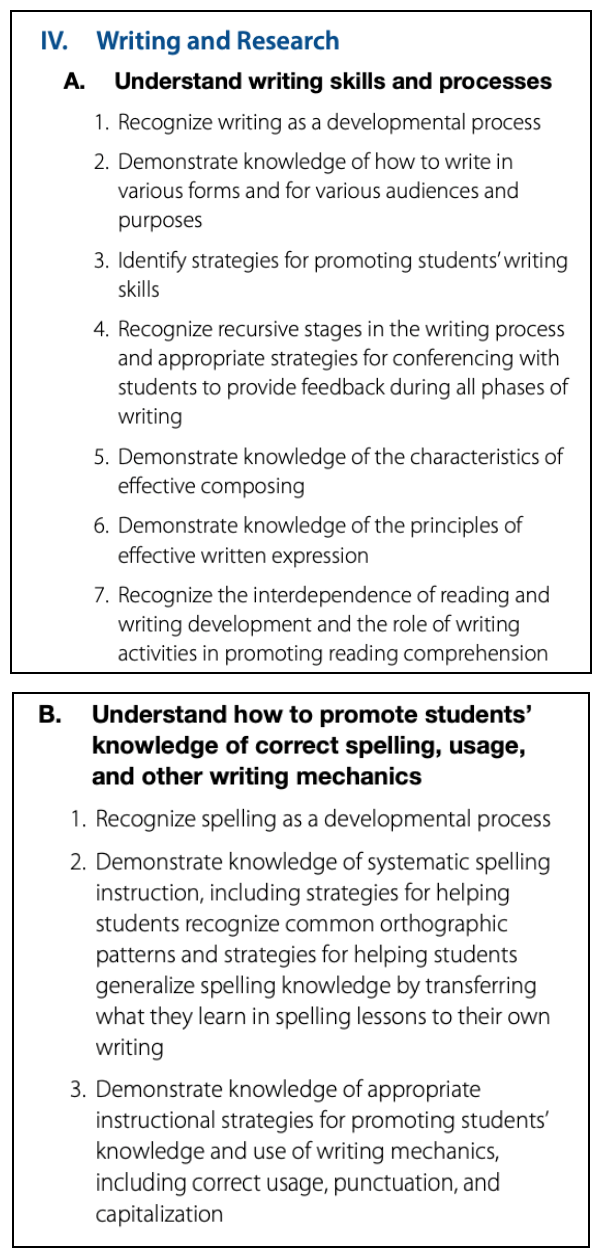

There are about 19 Writing and Research questions.
This section tests your knowledge on writing development and research skills, as well as strategies and tools used to help students during these processes.
Here are some specific concepts that will more than likely appear on the test.
Stages of the Writing Process
The stages of the writing process include prewriting, drafting, revising, editing, and publishing. At each stage, the teacher can provide different ways to help students. An explanation of each stage and some suggestions on how to help students are listed below:
Prewriting:
This is the planning stage of writing. During this time, students will brainstorm ideas and/or research information, then put these ideas into a logical sequence. You can help students during this time by modeling how to come up with ideas, providing younger students with a starting point for their ideas, and providing students with graphic organizers, such as outlines or storyboards for them to plan the sequence of their writing.
Drafting:
This is when students create the first draft of their writing. Even though it is a draft, students should still attempt to use proper punctuation and write complete sentences. You can help students during this process by modeling how to use a prewriting outline to create complete sentences and paragraphs. You can also encourage students to use transition words such as, “First, next, then, and last” when necessary, and provide younger students with sentence starters to help them put their thoughts into sentences.
Revising:
This is when students read over their work and rearrange, add, or delete sentences and/or paragraphs. Revising helps students improve the content of their writing so that it makes more sense to the reader. During this stage of the writing process, you can encourage students to read their writing out loud to themselves to make sure it makes sense. You can also read a student’s work out loud to them for the same purpose. Students can also benefit from reading their paper to a peer and asking for suggestions.
Editing:
During the editing stage, students review their work to correct grammatical errors or spelling mistakes. Students at this stage in the writing process may benefit from a “checklist” that they can use to make sure they have looked for correct spelling, capitalization, punctuation, etc. It can also be helpful to have students peer edit each other’s papers.
Revising and editing can often be confused with one another. Revising focuses on content, while editing focuses on mechanics and grammar.
Publishing:
This is the final stage of the writing process where students create their final draft of their writing. You can help students at this stage by reminding them to use the corrections and revisions they have already made and by providing them with various ways to publish their writing, such as a computer, lined paper, or even a class website or blog.
Writing Conferences
Writing conferences are when students meet with their teacher and/or peers for help and suggestions throughout the writing process. Writing conferences allow students to receive immediate feedback from their teacher and make adjustments or corrections to their writing when needed. Writing conferences can improve a student’s confidence in writing, because they are able to take ownership of their writing and make their own corrections, rather than receiving a finished paper with corrections from the teacher.
The teacher should plan to meet with students multiple times throughout the writing process and at various stages. Writing conferences can be a quick check-in or a more lengthy meeting with a student to review their paper. Conferences can be one-on-one with a teacher and student, a pair or group of students peer editing, or a small group of students meeting with the teacher at the same time.
Text Organizers
Text organizers (also referred to as graphic organizers) help students brainstorm ideas for writing, research information, and organize thoughts or information into a logical sequence. Graphic organizers include sequence outlines, main idea and detail outlines, brainstorming webs, Venn diagrams, cause-and-effect charts, and flowcharts. Graphic organizers can help focus and direct students while they research information by reminding them of what they need to look for in order to complete their writing. Once they locate the information or generate ideas, graphic organizers help students organize their research or their thoughts.
And that’s some basic info about Part A: Selected-Response Question of the RVE exam.
RVE Selected-Response Practice Questions
Question 1
Which of the following is not an acceptable form of informal assessment for an elementary class?
- Students play “Race the Clock” where students read as far in a literary selection as possible until the timer sounds (grades 2-3)
- Students roll a “Letter Die” and pick up a “Word Card” that correlates with that letter (grades K-1)
- Students play “Mad Libs” on the board filling in blanks with any creative words while the teacher facilitates the game (grades 2-3)
- Students play “Simon Says” and demonstrate/indicate the items expressed by the teacher (Simon). The words used are “behind, under, right, before, numbers” (grades 1-2)
Correct answer: 3.
The incorrect answers are appropriate informal assessments.
Question 2
A fifth-grade teacher is reading short passages or telling short segments from a variety of texts in order to help her students understand about the way written text is typically organized. Text organization includes all but which of the following:
- generalized order
- problems and their solution
- cause and effect relationships
- chronological order sequence
Correct answer: 1.
This is the correct answer. There is not such an order as “generalized.”
Question 3
A fifth-grade teacher wants to ensure that all her students know the elements, or story grammar, of narrative text. Which of the following discussion topics would best promote students’ retention of the narrative’s elements?
- Characters, setting, theme, plot, sequence, and solution
- Newspaper articles, magazines, and dictionaries
- Planning, drafting, revising, and editing
- Venn diagrams, charts, and graphs
Correct answer: 1.
This is the correct answer. These are some of the elements that you typically find in stories which are narrative text.
Question 4
Which of the following would be the most appropriate strategy when using below reading level books to increase reading fluency with a student who is struggling with grade level reading fluency?
- Provide opportunities for the student to read easy books to a younger student
- Encourage classmates to correct the struggling student during read aloud sessions
- Have an older student read easy books to the struggling student
- Have a younger student read easy books aloud to the older, struggling student
Correct answer: 1.
This activity allows a student to gain confidence in his reading while taking ownership of a reading activity by using a text that would be easy for the student to read fluently.
Question 5
Teachers want to use their instructional time effectively and efficiently in order to enhance student learning. Therefore, they want to ensure that all activities will make the best use of this time in all areas, including literacy development. Which of the following activities will probably not promote literacy development?
- Reading aloud to students, holding book discussions, and teaching them to make predictions
- Locating information, reading aloud, writing one day a week, and understanding test-taking strategies
- Responding to the text after reading such as with class discussions, retelling, dramatic play, and/or the use of technology
- Teaching students to self-monitor, visualize topics or events, and develop questions about the text
Correct answer: 2.
The problem with these activities is the minimal amount of time spent on them. Reading aloud and writing one day a week is not enough practice to have a great impact on literacy development. Test-taking strategies are often helpful before a criterion- or norm-referenced test.
Question 6
Students in the fifth-grade typically have a mastery of the elements of the alphabetic principle. However, teachers need to have a clear understanding of this principle in order to be aware of any student’s difficulties in this area. What are the elements of the alphabetic principle?
- Reading fluency, word identification skills, and letter names
- Letter names, graphophonemic knowledge, and the relationship of printed words to spoken language
- Phonemic awareness skills, schema development, and graphophonemic development
- Structural analysis, letter names, and the relationship of printed letters to spoken language
Correct answer: 2.
This is the correct answer. These are the major elements of the alphabetic principle.
Question 7
Emergent literacy development means that:
- children understand that written language has messages and makes sense.
- students have mastered their phonemic awareness skills, vocabulary development, and the ability to use structural analysis; students easily develop questions about what has been read.
- children recognize many words and can apply phonics and word analysis skills.
- students have mastered their phonemic awareness skills, vocabulary development, and the ability to use structural analysis.
Correct answer: 1.
This is the correct answer. This is considered the emergent stage of literacy development
Question 8
Place the following Reading Stages in the correct order of reading ability from low to high:
- Proficient, Early, Fluent, Emergent
- Early, Emergent, Proficient, Fluent
- Emergent, Early, Proficient, Fluent
- Early, Fluent, Proficient, Emergent
< Correct answer: 3.
This is the correct answer. The stages are Emergent, Early, Proficient, and Fluent.
Question 9
A teacher asks an open-ended question in a fifth-grade classroom about the literary piece the class just finished. The students are required to give their answer with support directly from the text. This is to assess and improve which of the following?
- Comprehension
- Sequencing
- Fluency Vocabulary
- Vocabulary
Correct answer: 1.
This is the correct answer. Students need to be able to explain and show how they came up with their answer.
Question 10
Mary is reading a book and is making judgments and decisions beyond what is stated in the text of the book. Which of the following methods of comprehension is Mary using?
- Inferential
- Literal
- Vocabulary
- Internal
Correct answer: 1.
Inferential comprehension is the ability to make judgments and decisions beyond what is explicitly stated in the text.
Question 11
Some vowel patterns can be associated with more than one pronunciation (for example, the “oo” sound in book and moon). Which of the following nonsense words has the vowel pattern with the most consistent pronunciation?
- Mook
- Goan
- Drow
- Zough
Correct answer: 2.
The “oa” vowel pattern is consistently pronounced with a “long o” pronunciation.
Question 12
Phonological awareness is the ability to identify:
- individual words, sounds, and syllables.
- phonics.
- syntax.
- individual sounds.
Correct answer: 1.
Phonemic awareness, not phonological awareness, is the ability to identify individual sounds, divide words into individual sounds, and blend together sounds. Phonics is recognizing sounds and the corresponding letters. Syntax relates to the rules that guide the building of words into phrases, clauses, and sentences.
Question 13
A first-grade teacher can formally and informally assess students’ phonemic awareness development in a variety of ways including all EXCEPT:
- having the student give rhymes to short words that the teacher gives orally.
- having the student read silently and write down certain syllables.
- repeating the words back after the teacher says them aloud.
- having the student blend together sounds into words that the teacher gives orally.
Correct answer: 2.
When a student is reading silently, the teacher cannot assess the pronunciation. Also, phonemic awareness is the ability to hear individual sounds, not necessarily read them. Therefore, this is the answer to the question.
Question 14
Which of the following would not be one of the appropriate strategies to promote letter identification among first-grade students at the beginning of the school year?
- Students use magnetic or paper letters to hold up when the teacher calls out a specific letter from the beginning of a word
- Students write the alphabet in order every morning when they come into class
- Students identify individual letters when the teacher uncovers one letter at a time from a written word
- Students write the beginning letter in the air or on the carpet when the teacher says a word
Correct answer: 2.
This does not necessarily help students identify letters unless they also pronounce the letters as they write them. Therefore, this is not a strategy that is especially helpful for letter identification in a first-grade class, at the beginning of the school year.
Question 15
A teacher notices that students are having difficulty decoding words like “moon”, “groan”, and “boat”. Which of the following areas of instruction should the teacher plan to support students’ decoding skills?
- Open syllables
- Vowel digraphs
- Phoneme blending
- Word syllabication
Correct answer: 2.
Vowel digraphs are two vowels that make one sound. All the words listed have two vowels that make one sound, which can be difficult for students to properly pronounce and thus, properly understand the word.
Question 16
How many phonemes are in the word “hat”?
- 1
- 2
- 3
- 4
Correct answer: 3
. A phoneme is the smallest unit of speech that can be used to make one word different from another word. In the word “hat” the sounds /h/, /a/, and /t/ are all distinct phonemes.
Question 17
A Kindergarten teacher assesses a student by asking questions based on the following scenario:
The teacher says, “Listen to me as I say some words very slowly. If I say /c/ /at/, you know the word is ‘cat’. What would the word be if I said /d/ /og/?”
This teacher is assessing what skill?
- Deleting final sounds
- Blending Phonemes
- Print Awareness
- Listening Comprehension
Correct answer: 2.
This is the correct answer. The teacher is assessing students’ ability to blend sounds together to make them into words.
Question 18
Mr. Martin’s fourth-grade class includes some emergent readers who are new to the country. He reads them a story with many pictures stopping frequently to discuss what is happening based mostly on the pictures along with a few major events. In what way could this best increase the reading development of these emergent readers?
- Increase their understanding of expository text
- Help students understand conventional spelling
- Help students identify story elements and vocabulary
- Enhance their skills in segmentation
Correct answer: 3.
By pointing to and then repeating the name of pictures of characters or important events, emergent readers can begin to understand the basics of what is happening in the text. From repeating the key characters or points, their vocabulary can be increased.
Question 19
The smallest individual sounds in a word are called:
- phonemes.
- morphemes.
- segments.
- pragmatics.
Correct answer: 1.
This is the correct answer. Phonemes are the smallest individual sounds in a word.
Question 20
Follow-up activities are crucial to enhancing elementary students’ listening skills. Which one of the following activities would be most appropriate for students who are new to the country and have limited reading/writing skills in English?
- Writing questions and/or answering written questions
- Acting out parts of the story after writing about main points
- Asking a partner questions about the story and recording his/her answers
- Having a class discussion about key points of the story and then having the students perform a dramatic play about these events
Correct answer: 4.
Acting out a story or parts of a story is an excellent follow-up activity for ELL and other students in that the teacher can check for listening comprehension.
Question 21
Ms. Ader wants her students to develop an understanding of how to write for different audiences. Which of the following writing activities will best address this goal?
- Students write to a friend about their school experiences so far. Students then rewrite the letter for their teacher.
- Students write instructions for a board game.
- Students write a thank-you note to the local firefighter station. Students then write a thank-you note to the local police station.
- Students write to their principal requesting a day off. Students then write to the assistant principal asking for a day off.
Correct answer: 1.
Students will write differently to their friend than to their teacher. These are two very different audiences, as one audience (the friend) is informal and the other audience (the teacher) is more formal.
Question 22
A third-grade teacher wants her students to use academic vocabulary when writing about a recent vacation, trip, or memory. Which of the following types of assignments should the teacher assign to encourage and allow students to use academic vocabulary in their writing assignment?
- A narrative story about the event
- A poem using rhyming words about the event
- An expository essay about the event
- A fictional story based upon the event
Correct answer: 3
. An expository essay is not creative in nature; it is a nonfiction recounting of events. Of all the options, this style is most conducive to academic vocabulary.
Question 23
Mrs. Hamilton is reviewing her students’ writing development and observing their present writing skills. Mrs. Hamilton observes the following:
Student 1: The student spells most words as they sound
Student 2: The student writes all letters in lowercase without any spacing
Student 3: The student’s marks on the paper resemble a drawing
Student 4: The student writes letters and words but sometimes forgets to properly space the words
Based on the observations above, which of the following students displays the most advanced stage in their writing?
- Student 4
- Student 1
- Student 2
- Student 3
Correct answer: 2.
Student 2 displays characteristics of an early stage of writing development known as “Strings of Letters.” Student 3 displays characteristics of an early stage of writing development known as “Scribbling.” Student 4 displays characteristics of an early stage of writing development known as “Initial, Middle, and Final Sounds.”
Question 24
A fourth-grade teacher wants to improve the students’ ability to revise, edit, and publish their written work. Which of the following activities would best address this in preparation for future writing modes?
- Have individual conferences with students to point out changes you would make in the essay
- Pair up the students to read each other’s writing
- Make sure assessments and feedback are formative and timely
- Instruct and allow practice in word processing technology for an essay they are writing on an assigned topic
Correct answer: 4.
By simply reading the other student’s work, there is no revision or editing of work. Having individual conferences with students is an incorrect answer even though it could be helpful in students’ writing development at early stages of going through the writing process. Making sure assessments and feedback are formative and timely is incorrect in that the question is relating to ways that students can improve their abilities in revising, editing, and publishing their work.
Question 25
A teacher assigns the students a research paper. The teacher arranges for his students to use the computer lab during class for research on the Internet. Which of the following would NOT be an appropriate research skill to teach students?
- Students should use the Internet to develop a research plan
- Students should check to make sure any information is current and comes from an authoritative source
- Students should utilize multiple valid websites for research resources
- Students should analyze websites for validity
Correct answer: 1.
Students should have a research plan before beginning Internet research.
RVE Part B: Constructed-Response Questions
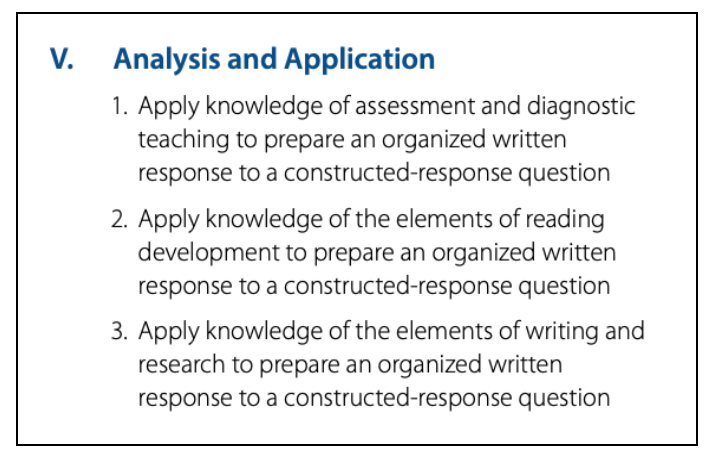
Part B has about 3 constructed-response questions.
The constructed-response portion of the test will ask you to apply your knowledge of reading development to answer open-ended questions related to reading instruction. The knowledge and information needed to answer these questions will be the same as what was needed for the selected-response questions, but you will be applying this information to create a short answer response. Each question will likely present you with a scenario about reading instruction or assessment and then ask you to respond to one or more questions using specific strategies and teaching methods.
Constructed-response questions receive a score of a 0, 1, 2, or 3 based on how thoroughly and accurately they answer the question.
- A score of 0 means the response does not correctly answer any part of the question or shows no knowledge of reading concepts relevant to the question.
- A score of 1 means the response shows a limited understanding of reading instruction or does not answer the most important part of the question.
- A score of 2 means the response shows a general knowledge and understanding of reading instruction and answers most parts of the question appropriately. To receive a score of 2, you also need to provide evidence or reasoning for your response by explaining why you chose your answer. This reasoning should be based on your knowledge of reading instruction.
- A score of 3 means the response shows a strong and thorough knowledge of reading instruction and answers all parts of the question appropriately. As with a score of 2, supporting evidence and reasoning should be used to further explain your answer.
Responses should be organized into a logical order and separated into paragraphs. You should start by explaining what you would do in each scenario, and then explain your reasoning by using your knowledge of best practices for reading instruction. Be sure to reference specific strategies, tools, or assessments used in reading instruction.
While there is no minimum length requirement, answers that receive a 2 or 3 are typically 3 – 5 paragraphs in length. This allows you to fully answer the question and provide the necessary evidence and reasoning.
After you have written your response, read over your answer to make sure that you have answered all parts of the question and that you have answered the specific question that was asked. It is easy to begin an answer and then go down a different path, leading you to not actually answer the question.
Look over your work for grammatical errors and make sure your response makes sense, but keep in mind that you should take about 15 minutes for each constructed-response question. Test scorers will also take this into account when scoring your response. They are mainly looking for accuracy, detail, and a thorough knowledge of reading instruction.
And that’s some basic info about Part B: Constructed-Response Questions of the RVE exam.


